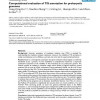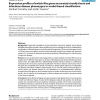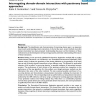BMCBI
2008
13 years 11 months ago
2008
Background: Tight clustering arose recently from a desire to obtain tighter and potentially more informative clusters in gene expression studies. Scattered genes with relatively l...
BMCBI
2008
13 years 11 months ago
2008
Background: Accurate annotation of translation initiation sites (TISs) is essential for understanding the translation initiation mechanism. However, the reliability of TIS annotat...
BMCBI
2008
13 years 11 months ago
2008
Background: Probability based statistical learning methods such as mutual information and Bayesian networks have emerged as a major category of tools for reverse engineering mecha...
BMCBI
2008
13 years 11 months ago
2008
Background: Large-scale compilation of gene expression microarray datasets across diverse biological phenotypes provided a means of gathering a priori knowledge in the form of ide...
BMCBI
2008
13 years 11 months ago
2008
Background: Phylogenies, i.e., the evolutionary histories of groups of taxa, play a major role in representing the interrelationships among biological entities. Many software tool...
BMCBI
2008
13 years 11 months ago
2008
Background: FREGENE simulates sequence-level data over large genomic regions in large populations. Because, unlike coalescent simulators, it works forwards through time, it allows...
BMCBI
2008
13 years 11 months ago
2008
Background: The identification and characterization of interacting domain pairs is an important step towards understanding protein interactions. In the last few years, several met...
BMCBI
2008
13 years 11 months ago
2008
Background: Prediction of disulfide bridges from protein sequences is useful for characterizing structural and functional properties of proteins. Several methods based on differen...
BMCBI
2008
13 years 11 months ago
2008
Background: The prediction of conformational B-cell epitopes is one of the most important goals in immunoinformatics. The solution to this problem, even if approximate, would help...
BMCBI
2008
13 years 11 months ago
2008






